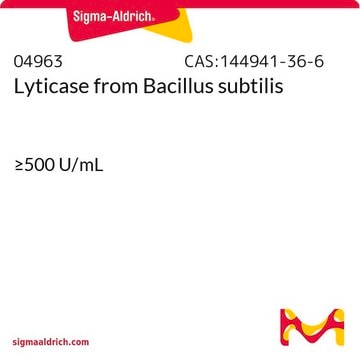The milligram quantity of this product will vary from lot to lot. The vial content is dependent upon the protein content and enzymatic activity. The minimum protein content will be 20% and the minimum activity will be 2000 units per milligram of protein. As an example, a batch that reports a protein content of 20% and an activity of 5000 units per milligram protein will have a vial content of 2 mg for the 10,000 unit package size. The protein content and activity are reported in the product Certificate of Analysis. Please see the link below to review a sample or lot specific Certificate:
https://www.sigmaaldrich.com/product/sigma/l2524#product-documentation
推薦產品
生物源
bacterial (Arthrobacter luteus)
品質等級
形狀
lyophilized powder
比活性
≥2,000 units/mg protein
成份
Protein, ≥20% biuret
技術
cell based assay: suitable
適合性
suitable for cell lysis
應用
diagnostic assay manufacturing
儲存溫度
−20°C
尋找類似的產品? 前往 產品比較指南
應用
- 制备原生质球
- 作为消化液组分,用于孵育酵母细胞消化细胞壁
- 酶解菌丝体沉淀以制备原生质体
生化/生理作用
單位定義
外觀
其他說明
訊號詞
Danger
危險聲明
危險分類
Resp. Sens. 1
儲存類別代碼
11 - Combustible Solids
水污染物質分類(WGK)
WGK 3
閃點(°F)
Not applicable
閃點(°C)
Not applicable
個人防護裝備
Eyeshields, Gloves, type N95 (US)
從最近期的版本中選擇一個:
分析證明 (COA)
客戶也查看了
條款
本程序可用於以 Baker's yeast 為底物的溶酶活性測定。
This procedure may be used for the determination of Lyticase activity using Baker’s yeast as the substrate.
-
How many milligrams is 10,000 units of Product L2524 Lyticase from Arthrobacter luteus?
1 answer-
Helpful?
-
-
Is it purified downstream by affinity chromatography or is it just an ammonium sulfate precipitate?
1 answer-
This product is purified by conventional chromatography following the initial ammonium sulfate precipitation process.
Helpful?
-
-
What is the recommended working concentration of L2524, if a typical 10mg/ml concentration of L1412 is used?
1 answer-
There have been no tests conducted for product L2524 application on the fungus Aspergillus fumigatus. However, according to a citation in Vet Pathol, 2U/100 ul of fungal extraction has shown good results. The citation is titled "Panfungal Polymerase Chain Reaction for Identification of Fungal Pathogens in Formalin-Fixed Animal Tissues" and was published in July 2017. The DOI is 10.1177/0300985817698207, and the PMID is 28346123
Helpful?
-
-
What is the molecular weight of this product?
1 answer-
The molecular weight of Lyticase has not been determined.
Helpful?
-
-
What is the molecular weight of this product?
1 answer-
The molecular weight of Lyticase is not determined.
Helpful?
-
-
I see it is suggested to reconstitute Lyticase fresh. However, if that is not possible, can you store reconstituted Lyticase, L2524, at -20C? If so, for how long?
1 answer-
The solution stability of this product has not been determined. However, according to Cold Spring Harbor Protocols, lyticase may be stored up to 6 months at 4 deg. C when prepared in 10 mM Tris-CL containing 20% glycerol. This has not been validated. See the link below to this citation:
https://cshprotocols.cshlp.org/content/2017/2/pdb.rec090381.full?rss=1Helpful?
-
-
How can I store Product L2524, Lyticase, once reconstituted?
1 answer-
When lyticase is reconstituted and stored, it may be stable for no more than 4-6 hours before serious loss of activity is observed. It is suggested that fresh solutions be prepared for use.
Helpful?
-
-
How do I solubilize Product L2524, Lyticase?
1 answer-
The quality control enzymatic assay protocol for Lyticase uses cold deionized water to make a solution at 500 units/mL.
Helpful?
-
-
How can Product L2524, Lyticase, be used to make yeast spheroplasts?
1 answer-
The use of lyticase in combination with chitinase and glucuronidase in the preparation of spheroplasts from C. albicans has been described in the following reference: Calvert, C.M., and Sanders, D., "Inositol Trisphosphate-dependent and -independent Ca2+ Mobilization Pathways at the Vacuolar Membrane of Candida albicans". J. Biol. Chem. 270, 7272-7280 (1995).
Helpful?
-
-
What is the Department of Transportation shipping information for this product?
1 answer-
Transportation information can be found in Section 14 of the product's (M)SDS.To access the shipping information for this material, use the link on the product detail page for the product.
Helpful?
-
Active Filters
我們的科學家團隊在所有研究領域都有豐富的經驗,包括生命科學、材料科學、化學合成、色譜、分析等.
聯絡技術服務








